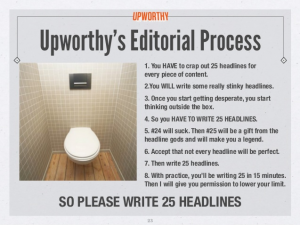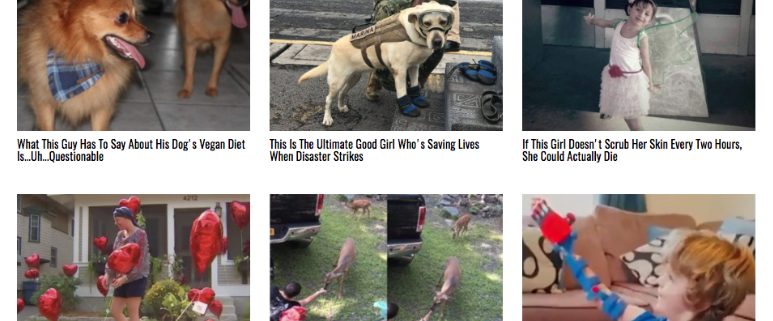This post was first published by Melissa Drozdowski on Interprose’s blog, Interprose Voice.
You’ve seen a million clickbait headlines, just like the one at the top of this post. They’re catchy. They’re clever. They’re abrasive and punchy. They pique your interest enough that you go ahead and click through to that article you had no intention of reading. And when you do click through, that cheesy, clickbait-y headline has done its job.
Humor. Emotion. Sensationalism. Call it the Buzzfeed school of headline writing. Media sites like Buzzfeed, Upworthy, and ViralNova have all mastered the art of crafting seductive, provocative headlines that bring readers in, sometimes against their better judgment. Here’s just a small sampling of their recent headlines for your consideration:
- “We Ate Every Cheesecake from Cheesecake Factory and OH DEAR GOD” – Buzzfeed
- “A Cop Picked Up A Donated Helmet On 9/11. Months Later, He Found A Note Inside.” – Upworthy
- “Here’s How A Parenting Dispute Ended With A Mace-Filled Fight In Walmart” – ViralNova
While these fluffy, gimmicky headlines would probably earn sniffs of disdain from your typical Columbia School of Journalism graduate, there’s no denying they work. Venerable business pub FastCompany once declared Upworthy, which relies heavily on the emotional pull of its headlines, “the fastest growing media site of all time”. If that’s not proof of an effective strategy, I don’t know what is.
But, how do you leverage some of these proven techniques without succumbing to the temptation to go full clickbait with your headlines? Here are a few things you can do to help boost your headline-writing game:
Pick the Right Approach
Are you aiming at your reader’s funny bone? Plucking at their heartstrings? Appealing to their sense of outrage or intrigue? Making your headline pop means finding just the right approach, and then molding your copy around it. Looking for funny? Try throwing a pun or some alliteration in there. Heck, throw in the first line of a joke and see what happens. For more emotional impact, seek out those words and phrases that pack a visceral punch – detest, love, fury, sweet, justice, disgusting, brilliant, amazing, arrogant.
But before you settle on which direction you’ll take, heed this commandment: know thy content. Your copy has to match up with the content it’s headlining. You wouldn’t want to saddle an emotional tale with a whimsical headline, just like you wouldn’t hang a sensationalist headline on a scholarly piece.
Leave a Little to the Imagination
In a previous post, I mentioned that the human attention span has deteriorated to the point of being shorter than that of your average goldfish. Seriously. What does this mean for your headlines? People today tend to consume headlines the same way they do content – by scanning.
If you tell the entire story in your headline, what reason do your readers have to click through to view the actual content? The short answer is, they don’t. Brevity is the soul of wit. So, keep your headlines short and punchy, and tell just enough of the story to tantalize readers.
Tell ‘em What They’re Getting
One of the important aspects of content marketing is to attract and engage audiences through added value. You want readers to pay attention? Then make it worth their while. Give them a learning experience, entertain them, introduce them to a new idea or concept…that’s how you add value. And now that you know most people today scan content, how can you alert readers that your content contains something worth their time? Simple: incentivize your headline.
Adding a tag to the end of your well-written headline will encourage readers to delve into your content. Take this headline for example: “How to tell if your cat owns you or if you own your cat [infographic]”. Adding that [infographic] tag to the end of my headline tells people there’s more info to be had, if only they click through to check it out. Other popular tags these days include [podcast] and [report]. Give it a try and see how much your clickthroughs jump.
Write, Write, and Rewrite
Clickthrough powerhouse Upworthy requires its writers to “crap out 25 headlines for every piece of content.” While this might seem a bit drastic at first, it’s actually a genius tactic. Why? Because it forces writers to think outside the box.

25 headlines? We’re gonna be here awhile.
The old saying goes, “Necessity is the mother of invention”, but I disagree – the true driver of invention is desperation. Churning out headline after headline forces you to sharpen your writing skills to a razor-fine point. And Upworthy is right – you’ll come up with headlines that are truly awful. Like biting into a piece of tin foil awful. But, it’s just a part of the creative process that you’ll have to get used to. You may have to kiss a whole lot of frogs before finding a prince, but you’ll get there. So write, write, rewrite, and then write some more.
Crunch the Numbers.
I’ve got a secret headline weapon…and what it does will amaze you! Now that I’ve got your attention, I’ll let you in on my little secret: I use multiple headline analysis tools to determine how well my headlines are working. Shocking, right?
There are a number of free online analyzers that will assess the quality of your copy. The higher your headline’s score, the more likely it is to draw audiences in for a closer look. My two favorites analyzers belong to CoSchedule and the Advanced Marketing Institute (AMI). Input a headline (or 25), and these neat little tools will give you a numeric score on a scale of 1 – 100, along with a fairly detailed report that includes things like word balance, length, emotional classification, and more. The better your score, the more likely it is your headline pull readers in. I tend to rely on CoSchedule’s analyzer for creative or expository writing (like this blog post), and AMI’s analyzer for press releases, but both are ideal for checking whether you’re on the right track with your headline.
By the way? The headline on this post scored a respectable 62 in CoSchedule’s analyzer.
So what happens when a writer pens a killer headline? She becomes a clickthrough hero. And now you can be one, too. What are you waiting for? Go make it happen.
This post was inspired by my colleague, Melissa Power, whose insightful commentary on email subject lines was just published by Bulldog Reporter. You should go check it out.

